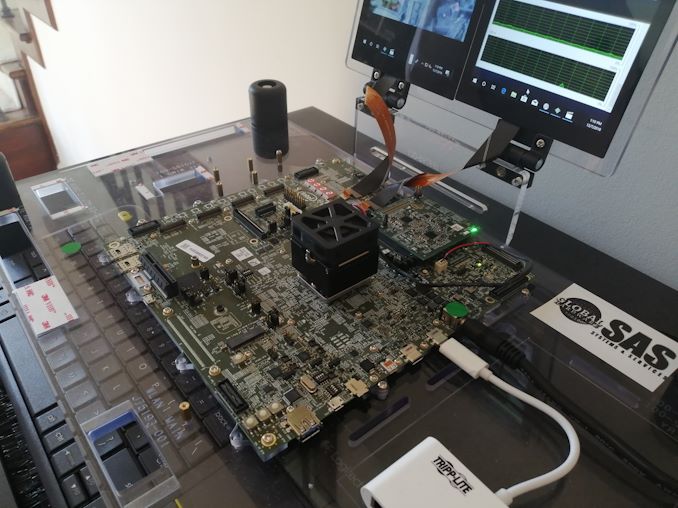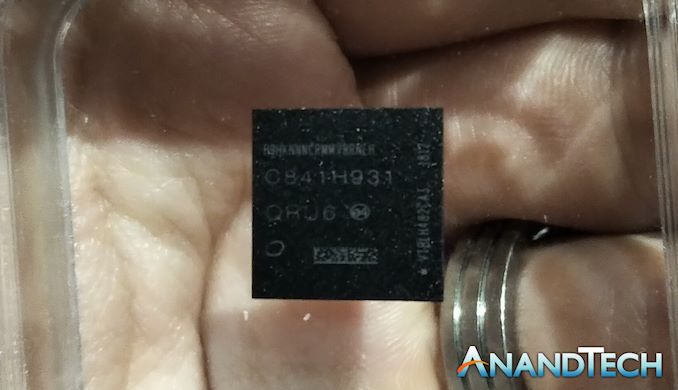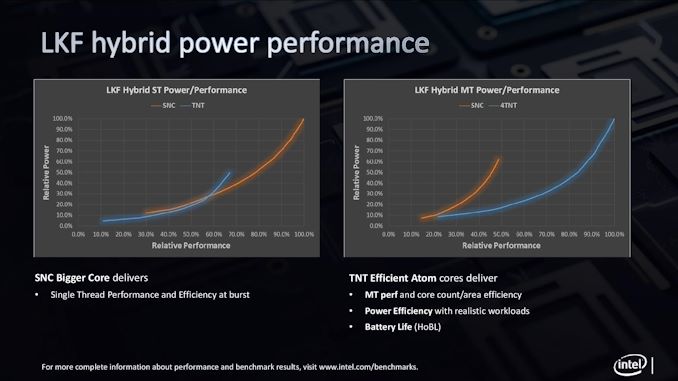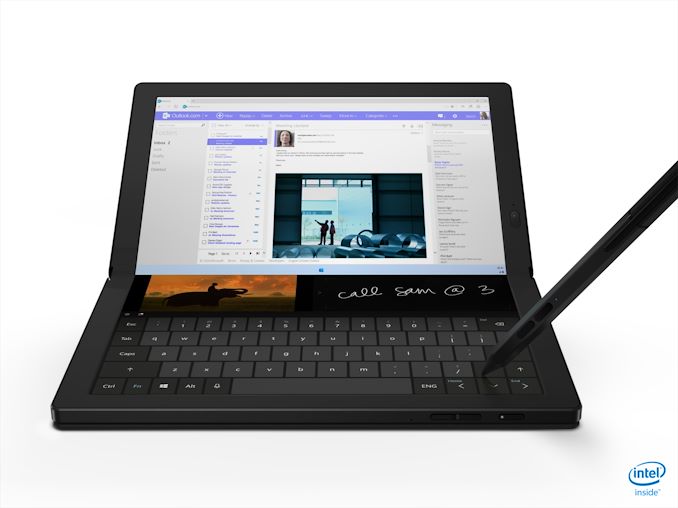Intel Discloses Lakefield CPUs Specifications: 64 Execution Units, up to 3.0 GHz, 7 W
by Dr. Ian Cutress on June 10, 2020 11:00 AM EST
Over the past 12 months, Intel has slowly started to disclose information about its first hybrid x86 platform, Lakefield. This new processor combines one ‘big’ CPU core with four ‘small’ CPU cores, along with a hefty chunk of graphics, with Intel setting out to deliver a new computing form factor. Highlights for this processor include its small footprint, due to new 3D stacking ‘Foveros’ technology, as well as its low standby SoC power, as low as 2.5 mW, which Intel states is 91% lower than previous low power Intel processors. Today’s announcement comes in two parts: first, the specifications.
Intel will debut these two SKUs in its first generation of Lakefield. These CPUs will find homes in premium, always-connected laptops, such as the Samsung Galaxy Book S expected in markets this month, the Lenovo ThinkPad X1 Fold, coming later this year, and in the Microsoft Surface Book Neo.
Both SKUs will feature one big ‘Sunny Cove’ CPU core, along with four little ‘Tremont’ Atom CPU cores. Both sets of cores will have access to a 4 MB last level cache, although Intel has not yet disclosed what sort of cache this is.
Meanwhile on the graphics front, Intel is integrating a Gen11 GPU with 64 execution units, the same number of EUs as on Intel's Ice Lake processors. Interestingly, the iGPU is clocked about half as high as usual for an Intel GPU, with clockspeeds peaking at just 500 MHz – suggesting that Intel is going wide and slow to increase graphics performance. Both CPUs will be rated for a TDP of 7 W.
| Intel Lakefield Processors | ||||||||
| AnandTech | Cores | Base Freq |
1C Turbo |
nT Turbo |
Gen11 IGP |
IGP Freq |
DRAM LP4 |
TDP |
| i5-L16G7 | 1+4 | 1400 | 3000 | 1800 | 64 EUs | 500 | 4267 | 7 W |
| i3-L13G4 | 1+4 | 800 | 2800 | 1300 | 48 EUs | 500 | 4267 | 7 W |
Intel confirmed to us that the base frequency is the unified frequency across all five cores, and the single core turbo frequency applies only to the big Sunny Cove core. Support for LPDDR4X-4266 is a notch above the memory controller in Ice Lake, which only runs at LPDDR4X-3733, and the memory speed will likely be a big boost to performance.
In order to enable these processors in a small 12mm x 12mm footprint, Intel is using its 3D stacking technology, called Foveros. This means that the logic areas of the chip, such as the cores and the graphics, sit on a 10+ nm die, while the IO parts of the chip are on a 22nm silicon die, and they are stacked together. In order to make the connections work, Intel has enabled 50 micron connection pads between the two silicon halves, along with power-focused TSVs (through silicon vias) in order to power the cores on the top layer.
Intel lists the TDP for these chips at 7 W, although the company has not disclosed the turbo power limits for the chip. As mentioned above, Intel hasn’t disclosed how the cache works. In the initial diagrams, we were shown that PoP memory would be added on top, and while Intel hasn't offered further details there, we know from last month's Samsung Galaxy Book S reveal that there will be (at least) 8GB SKUs using LPDDR4X.
We have big questions as to how each of the cores will work, given that by default they support different instruction sets – Intel hasn’t provided information on this at this time. Intel has stated that the scheduling of the threads on the different parts of the CPU will occur based on hardware-guided OS scheduling, although again Intel hasn’t gone into the details of its hardware tracking and enablement on how this is done. In the demos we have seen, Lakefield will use the Tremont cores for almost everything, and only call on the Sunny Cove core for user-experience type of interactions, such as typing or interacting with the screen.
Intel is planning a post-announcement briefing for press to ask questions, which means that this announcement is coming in two parts. This is the information we’re being given beforehand, and we will update you with the details from the post-announcement briefing. As part of this process, we’ve exclaimed to Intel how this way around of presenting details to the press is frustrating – firstly for readers, as you all will have to come back if you want to find out what more Intel tells us later today, but secondly for us, as press, who will have to scramble to jump on the details and decide whether to write fast and miss details, or write slow and miss the wave of traffic.
One thing we can confirm in advance – the Sunny Cove does not appear to be AVX-512 enabled. Intel’s initial press release states that AI workloads occur on the CPU; given the extra power draw required for AVX-512, this is probably a good thing.
More information out of Intel’s post-announcement press-briefing will come later today.














78 Comments
View All Comments
drexnx - Wednesday, June 10, 2020 - link
who is naming these chips at intel?fire them immediately.
Sivar - Wednesday, June 10, 2020 - link
Fire someone for the names, "Lakefield", "Tremont", or "Sonny Cove"?drexnx - Wednesday, June 10, 2020 - link
no, i3-L13G4, i5-L16G7they just throw random numbers and letters that don't represent anything in their names - what makes it the 13 vs the 16? why is one a G4 and the other a G7?
they really need a geological feature other than "Lake" too, but that's another issue...
voicequal - Wednesday, June 10, 2020 - link
G7 = IGP w/64 EUsG4 = IGP w/48 EUs
G1 = IGP w/32 EUs
This has been consistent across Gen 11 IGPs, beginning with Ice Lake. Sort of mirrors the i3, i5, i7 branding, but on the GPU side of things.
phoenix_rizzen - Wednesday, June 10, 2020 - link
The G4 and G7 is fairly standard on the Ice Lake CPU SKUs, and relate to the number of EUs in the iGPU.The i3/i5 is dumb on these CPUs. They should have resurrected the m3/m5 monikers as these are mobile device chips.
The L13 and L16 is annoying.
m3-1013G4 would make more sense. It's an m3, 10th gen CPU, model number 13 (just a relative number to place it in the SKU stacK), with a G4 iGPU.
m5-1016G7 would make more sense. It's an m5, 10th gen CPU, model number 16, with a G7 iGPU.
Buyers can just compare m3 to m5, or G4 to G7 to figure out which one is better. Or, if they eventually release more m3 SKUs or m5 SKUs, compare the model numbers.
But, Intel's MO is to make things as confusing as possible when it comes to model numbers and features available.
Spunjji - Tuesday, June 16, 2020 - link
"But, Intel's MO is to make things as confusing as possible when it comes to model numbers and features available."Bingo. They're been doing it with Xeons for around a decade now. Create one incomprehensible naming scheme, then replace it with a completely incomparable and even less comprehensible scheme a few years later.
PaulHoule - Wednesday, June 10, 2020 - link
How about "Creek" as in "S⁴ Creek?"Intel has to get on the ball or it will be eaten by ARM and AMD.
yeeeeman - Wednesday, June 10, 2020 - link
Neah, you would believe that but Intel is doing just fine. Winning in a market is not only about silicon, it is also about software, firmware, integration, validation, quality, testing, end2end solutions, trust, etc.AMD has only a few of these traits. They happen to have good products, but they are far and away of eating Intel snack.
Irata - Thursday, June 11, 2020 - link
Hmmm....one thing is missing from this list. What could it be ?Security pehaps?
Deicidium369 - Friday, June 12, 2020 - link
If you allow someone lab unfettered access to your system you deserve to be hacked. There are ZERO exploits in the wild - they are more theoretical than practical.